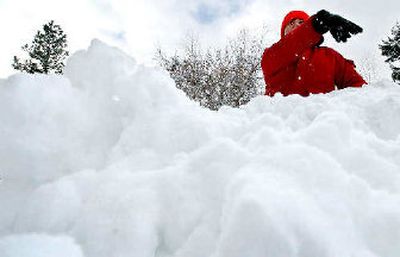More snow-going ahead for drivers

Snow accumulation and icy roads caused another flurry of minor crashes throughout the Spokane and Coeur d’Alene area Wednesday morning.
Officials breathed easier after the snow ended Wednesday morning but were already preparing for the next snowstorm – forecast to blow through Eastern Washington and North Idaho today, according to the National Weather Service.
“If the next storm hits as predicted, that will be one of the most major events in several years for snowfall,” said Wayne Storey, an operations and maintenance superintendent for Spokane County.
His and other road crews in the region were busy trying to clear the snow that fell Tuesday and Wednesday, even while looking ahead to today.
Whether because of the plowing or because drivers were being more cautious, Wednesday morning’s commute went far more smoothly than Tuesday evening’s.
The Spokane County Sheriff’s Office and Spokane Police Department responded to nearly 30 crashes Wednesday morning, compared to more than 200 Tuesday night when the storm was raging.
“None of them were serious,” Spokane Police Department spokesman Dick Cottam said. “Traffic has slowed down. It really works, it’s just slower, but it does save you from having an unpleasant collision.”
Washington State Patrol responded to a steady stream of crashes – and bad drivers – Wednesday morning.
“We had a woman in a Cadillac SUV on Harvard Road who wanted to drive faster than everyone else,” said Trooper Mark Baker. “She tried to use the sidewalks to pass. It cost her $101.”
Wednesday’s afternoon commute wasn’t as slippery, but two, three-car collisions about 4 p.m. on Interstate 90 near Hamilton Street significantly slowed the drive home, WSP reported. No one was hurt in the crashes
In fact, most of Wednesday’s collisions were minor and resulted in no major injuries.
“That seat-belt law, whether you like it or not, really saves lives,” said Baker.
Roads that were closed Tuesday night because of traffic crashes were reopened by Wednesday, including two stretches of U.S. Highway 95 south of Coeur d’Alene.
Idaho State Police Lt. Curtis Exley said conditions were still so treacherous that traffic could only go about 10 mph on the highway, even after it was plowed and reopened Wednesday morning.
In Spokane Valley, a driver crashed into a power pole about 6:30 a.m. Wednesday at Progress and Wellesley, shearing off the pole and knocking out power to about 40 homes, Spokane Valley Fire Chief Mike Thompson said. The driver appeared to be in shock and was taken to a hospital.
Tuesday and Wednesday’s snowfall had little impact on urban school districts, while smaller districts were hit harder.
“There were probably a few buses moving a little more slowly,” but none were running late, said Melanie Rose, Central Valley School District spokeswoman.
Pullman and Colfax school districts ran limited bus runs but started on time, while the Colton, Garfield-Palouse and Reardan-Edwall school districts ran two hours late.
Spokane Public Schools tries to keep its doors open during storms, despite pleas from some students hoping for a snow day, said district spokeswoman Terren Roloff.
Buses can run late on snowy days – some were 30 minutes late Wednesday – so students should dress warmly, Roloff said.
City, county and state crews are working around the clock to keep the streets sanded, plowed and de-iced.
Scott Egger, Spokane city street director, said it typically takes his crews – using 31 pieces of equipment – about 24 hours to plow all the city’s arterials after a storm.
Emergency access routes, such as Stevens, Grand, Division, Francis and Wellesley, are plowed first. Next are main roads in hilly areas, such as Rockwood Boulevard, Southeast Boulevard, Perry, Garland and Bridgeport.
“If we get back-to-back storms, we may have to stop halfway through and drop back and start all over again,” Egger said.
“One thing that people don’t understand is that we have to use more than one plow on one arterial,” he said. “It takes multiple plows to get the snow out of the road.”